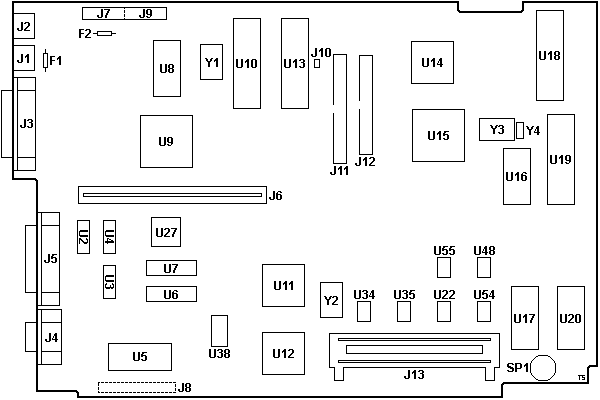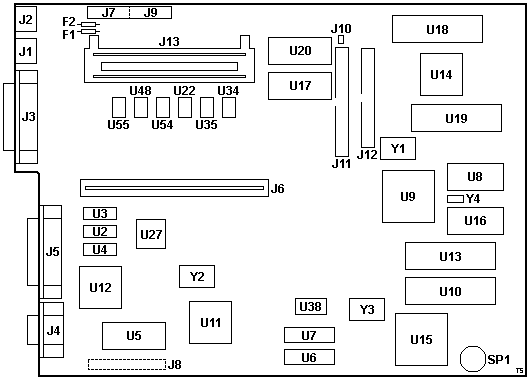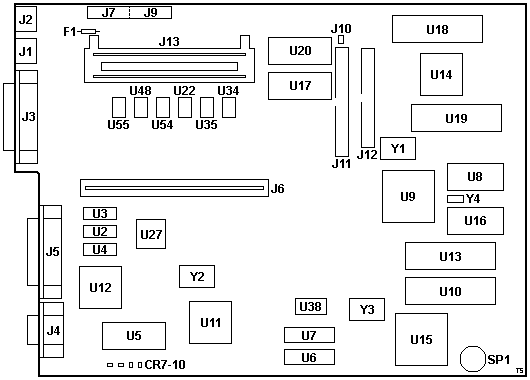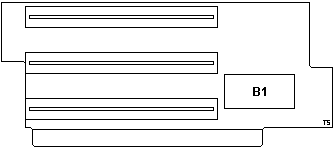|
30start.exe Model 30 Starter Disk v1.02 (zipped image)
adv30dig.exe Model 30 Advanced Diagnostics v1.05 (zipped image)
187-048 IBM PERSONAL SYSTEM/2 (TM) MODEL 30 (8530-002,-021)
SHS64F3987 IBM PS/2 Model 30 HMR
SHS15F2191 IBM PS/2 Model 25/30 HMS
PS/2 Model 30 Planar Registers (by "mkarcher" @ vogons)
8530 Power
ISA Interrupt Sharing (PS/2 Model 25 & 30)
MCGA - Multi-Color Graphics Array
8530 Planar
8530 Greenock Planar
8530 Greenock Planar (alt)
System Firmware
ROM Images
Riser Card
Known Problems
8530 Fixed Disk, System Board, Adv. Diags (H007157)
8530 Cursor Keys and 501 POST Errors (H043664)
8530 Bus Adapter Battery Voltage (H067282)
8515/8516 Exhibits Distorted Video When Attached to 8530 (H094152)
Model 30 Production Tales
8530 Planar "P-PLANAR", P/N 61X8823
![Front [P]](/other/img/photo.gif)
![Back [P]](/other/img/photo.gif) (schematics)
(schematics)

F1 Mouse fuse?
F2 Keyboard fuse?
J1 Mouse connector
J2 Keyboard connector
J3 Parallel port
J4 HDD15 video connector
J5 DB25 serial port
J6 Riser slot
J7,9 Power connector
J8 Pads for video feature connector
J10 2-pin keylock header
J11 44-pin HDD connector
J12 40-pin Floppy connector
J13 Dual 30-pin SIMM socket
SP1 Piezo speaker
U2,3 NS DS1489AN line revc.
U4 NS NS1488N line driver
U5 Inmos IMSG171S RAMDAC
U6,7 µPD41264C-15 64Kx4 DRAM (MCGA)
U8 Intel P8253-5
|
U9 SLA6430J GA 72X8203
U10 Intel 8086-2 CPU @ 8 MHz
U11 SLA6430J GA 72X8300 MCGA Mem. Ctrl.
U12 SLA6330J GA 72X8205 MCGA Video Fmtr.
U13 Intel 8087 socket
U14 SLA6140J GA 72X8206
U15 SLA6330J GA 72X8202
U16 NS MM58167AN RTC
U22,34,35,54 µPD41464-15 64Kx4 DRAM
U17 ROM BIOS
U18 NEC µPD765AC FDC
U19 8237A DMA controller
U20 ROM BIOS
U27 NS8250AV UART
U38 Epson SRM2264M-12 8Kx8 SRAM (MCGA)
U48,55 64Kx1 DRAM
Y1 14.31818 MHz osc
Y2 25.175 MHz osc
Y3 48.000 MHz osc
Y4 32.768 kHz xtal (RTC)
|
U48,55
OKI MSM3764A-15,
TI TMS4164-15, or compatible 64Kx1
DRAM
Note: Despite the drastically different PCB
layouts, the reference designators are largely consistent across all 8086-based
Model 30 and Model 25 planars.
This planar is also used in the IBM 7496 Executive
Workstation.
8530 Greenock Planar P/N 33F4888
![Front [P]](/other/img/photo.gif)

Different PCB layout, but the component references and types are the same
as on the P-PLANAR, except for
the following items:
U11 SLA6430J GA 11F8028 MCGA Mem. Ctrl. (new)
8530 Greenock Planar (alternative) FRU P/N 33F8474, P/N 33F4871(F)
![Front [P]](/other/img/photo.gif)
![Back [P]](/other/img/photo.gif)

Same as the other Greenock planar, except for
the following items:
CR7-10 RAMDAC clamping diodes were added (in place of J8)
F2 fuse is missing
J8 header artifact is missing
System Firmware (POST & BIOS)
Firmware stored in mask ROM or EPROM.
ROM Images
68X1687 / 68X1627 - 02 Sep 1986, rev. 0, 2x 27256 (U17 / U20)
61X8938 / 61X8937 - 12 Dec 1986, rev. 1, 2x 27256 (U17 / U20)
61X8940 / 61X8939 - 05 Feb 1987, rev. 2, 2x 27256 (U17 / U20)
33F4498 / 33F4499 - 31 Jan 1989, rev. 4, 2x 27256 (U17 / U20)
Riser Card P/N 61X8864
![Riser [P]](/other/img/photo.gif)

B1 3V lithium RTC battery (Panasonic BR-⅔A)
Three 8-bit ISA slots. 3V lithium RTC battery soldered to the board.
Known Problems
Erroneous/False Display Characters (ECA 023)
8530 Fixed Disk, System Board, Adv. Diags (H007157)
Successful fixed disk operation on the 8530 model 001 and 021 systems is
dependent upon using the correct combination of system board, hardfile, and
Advanced Diagnostics. Mismatch of the required FRU's or formatting the fixed
disk with the incorrect level of Advanced Diagnostics will cause fixed disk
errors.
Required FRU P/N and advanced diagnostics:
| Machine Type | System Board | Fixed Disk | Diags Ver. |
|---|
8530-021 below
serial #2500000 | P/N 61X8907 | P/N 61X8929 | 8530 Adv. Diags
any version |
8530-021 above
serial #2500000 | P/N 33F8474 | P/N 6128285 | 8530 Adv. Diags
ver. 1.05 |
| 8530-001 all | P/N 33F8474 | P/N 6128285
P/N 6128279 | 8530 Adv. Diags
ver. 1.05 |
| 8530-E21 (only) | P/N 27F4069 | P/N 6128285 | 8530-286 Adv. Diags
ver. 1.02 |
| 8530-E31 & E01 | P/N 34F0046 | P/N 6128285
P/N 6128279 | 8530-286 Adv. Diags
ver. 1.02 |
* Fixed disk P/N 6128285 and P/N 6128279 must not be installed in any 8530
model 021 below serial number 2500000.
* 8530 Model 021's above serial number 2500000 and all 8530 model 001's must
be formatted only with 8530 Advanced Diagnostics version 1.05.
8530 Advanced Diagnostics version 1.05 is available by ordering publication
number S15F-2153.
8530 Cursor Keys and 501 POST Errors (H043664)
Symptom
On a limited number of PS/2 8530 systems, use of the cursor movement keys
may cause unexpected characters to appear on the display. This problem is
limited to 8530 models 001 and 021 only. This problem may be intermittent, and
may not be detected by Advanced Diagnostics.
The 501 POST error appears when two or more option cards are installed in
the 8530. These options include the 3270
and Token Ring adapters (half size cards). This problem is also limited to 8530
models 001 and 021. The 501 will show as a display error.
Problem Isolation Aids
If symptoms appear as described, visually inspect the 8530 system board
modules in positions U9 and U15. Module u15 is next to the speaker and U9 next
to the math co-processor chip holder.
U9 P/N 72X8203 with IBM printed on chip is suspect
U15 P/N 61X8965 with IBM printed on chip is suspect
Good chips will have the word "Japan" printed on them; affected chips will
not.
System units with serial above 55-00HV000 have the new board factory
installed.
Fix
If the modules in position U9 and U15 do not have "Japan" printed on them,
the system board should be replaced by new system board FRU P/N 64F3453. The
removed system board should be returned to be updated to new EC level via
normal repair channels (ERC) (if the math coprocessor is installed it should be
removed and reinstalled in the new FRU).
8530 Bus Adapter Battery Voltage (H067282)
Early releases of the 8530 HMS (3-ring binder) maps, system board, page
0100-4, show incorrect pins for checking voltage on the bus adapter card.
In figure one, the pins labeled "0" and "39" should actually be labeled pins
"1" and "40". Correctly measuring the voltage is then done at pins 38 and 39
(the second and third pins from the right edge).
Replace the bus adapter card if voltage is less than 2.5 volts between the
correct pins.
8515/8516 Exhibits Distorted Video When Attached to 8530 (H094152)
Symptom
PS/2 8530 (8086 version) exhibits compressed and distorted video when
connected to a 8515 or 8516 display.
Problem Isolation Aids
- 8530 (8086 version) models 001, 002, and 021 do not support attached PS/2
8515 and 8516 displays.
- 8530 (8086 version) models 001, 002, and 021 are supported with the
following attached PS/2 displays: 8503, 8504, 8507, 8512, 8513, 8514.
- 8530 (286 version) models E01, E21, E31, and E41 are supported with the
following attached PS/2 displays: 8503, 8504, 8512, 8513, 8514, 8515, 8516.
Fix
Advise customer that 8515 and 8516 displays are not supported on 8086
version of the 8530, and they should consult their point of sale if required.
Normal problem isolation procedures should be used on supported displays
exhibiting the above symptoms.
Model 30 Production Tales (by VK3DRB @
EEVBlog Forum;
slightly edited)
I was involved in the initial introduction of the PS/2 Model 30 in late
1986. Code name was Palace. Considering you are in Australia, it most likely
originated from our IBM plant in Wangaratta. It was the first of the PS/2
models, followed shortly by the Model 50 and the Model 80. That machine cost a
fortune in its day, but it was well designed. I seem to recall there were two
BIOS chips... I think they were odd/even addresses. I used to have the entire
source code listing to the BIOS and Advanced Diagnostics on my PC at work,
which I used to hack to make tests from. It would not surprise me your machine
still functions. Prime spec parts were used throughout and the SMPS's were
extremely robust. You will find the RAM is ECC parity.
The amount of testing per machine leaves what is done today for dead. You
motherboard underwent a 12 hour dynamic burn-in test from about 5 °C to 65 °C,
then it was functionally tested on a FACT tester imported from Boca Raton in
Florida. (I now own that FACT test machine. The machine originally cost
$350,000. I bought it for $100 and stripped it down make a nice ESD bench with
built in power supplies.) As an assembled PC, your machine underwent further
extensive testing. Less than 1% valid warranty claims were received.
The Palace motherboard was most likely the first surface mount PCB to be
made in Australia, because we installed Australia's first SMT plant initially
for the PS/2 family. If it were made in Wang, I could tell you the names of
assembly and test people who put your machine together, and the names of the
engineers involved. When the Palace was made, the Wangaratta plant had only
about 90 full time personnel... a great place to work where we were like one
big family. At its peak 10 years later there were the equivalent of 600 full
time hires and we had the biggest electronics plant in the country by far. We
made a few MILLION PCs there for all of Australasia and some of EU and the USA.
The reason I moved to Wangaratta for the great opportunity to be at the
forefront of technology and get to travel around the world. We had a ball, and
in those days money was no object in getting things done. But in 1998, IBM
cashed in by selling us off to a shonky startup which ceased business about 2
years later, leaving in its wake a path of social, electronic and economic
desolation in Wangaratta.
A little known fact is that we also manufactured a very large volume of
Apple Power MAC processors. My job was developing the hardware and software for
the testing them. Because of the Power MAC and the IBM RISC systems, in 1995 we
were the biggest exporter of non-primary produce in Australia.
...
There were two 27C512's 27[C]256's in the machine,
containing BIOS. The chips shared the 16 address lines. One supplied the lowest
8 bits of data, the other the highest 8 bits of data (ie: odd/even byte
arrangement). Many of the chips on that board and others from the era were from
VLSI Logic. I have no idea what happened to VLSI Logic, but they were a key
vendor to IBM for a few years.
IBM never supplied BASIC in PROM on any of their machines, except on
the old 5100, 5110 and 5120 minicomputers (which I also worked on). For PC's,
BASIC was always supplied on diskettes or cassette. (Ed. This is of course incorrect...)
Another fact about IBM boards is they never had NiCad batteries in them. It
was against company policy to design anything with them in due to the cadmium
environmental pollution. Most clones however had NiCad cells in them.
|